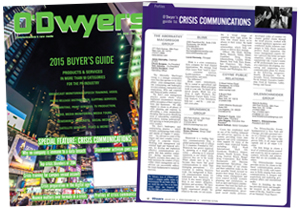 A good number of crisis communication programs have been heralded as textbook success stories over the years. And while many make for interesting case studies, it would be a mistake to assume these programs could be equally successful in the current media environment. It’s the instinct that comes from those experiences that enables you to bring focus to an otherwise blurry terrain.
A good number of crisis communication programs have been heralded as textbook success stories over the years. And while many make for interesting case studies, it would be a mistake to assume these programs could be equally successful in the current media environment. It’s the instinct that comes from those experiences that enables you to bring focus to an otherwise blurry terrain.
A successful crisis response will require skillfully managing the challenges presented by the ever-changing media environment with a careful eye on four “new realities.”
The lifecycle of a news cycle
Limiting the number of news cycles reporting on a crisis event is key to mitigating the event’s lasting reputational impact. As the news cycle continues to contract, one might assume limiting the news cycle has become easier to accomplish, and sometimes that is the case. But, more often we’ve often seen the tonality of coverage become even more relentless.
|
|
Whether online, on air or still in print, the pursuit of eyeballs is increasingly driving editorial decisions. Advancing the story is no longer a precondition for yet another report on a particular topic. Instead, aggressive (and sometimes misleading) headlines seek to capitalize on interest and popularity. All too often, “click bait” rather than information drives the narrative.
This change in the media landscape means it’s vital to remain vigilant and aware of the most subtle shifts in the narrative. It also requires a running assessment on whether and how to engage. Judgment calls will determine whether a more forward leaning posture will extend the news cycle, or positively influence the discussion. Decisions will be made about which media to engage, what opportunities have the best chances to positively frame the overall narrative, and, conversely, which should be avoided.
A continuum of truths
Communicators have long been instructed to adopt a three-pronged crisis approach: 1) communicate the facts as soon as you know them, 2) avoid speculation, and 3) quickly correct mistakes. But if marshalling the facts during an unfolding crisis isn’t tough enough, consider the challenge of doing so in an arena where the truth is viewed as more of an aspiration than a reality. In today’s fast paced media environment, the “truth” is often viewed not as a recounting of what actually happened, but rather as a full-throated defense of your position. Media are increasingly relying on branded “fact checkers” to decide whether statements are mostly, partly or half true, and then assigning them a number of Pinocchios.
This evolving landscape underscores how heavily successful response to a crisis depends on establishing and maintaining credibility. Letting the facts speak for themselves, unless they are conclusive and irrefutable, is unlikely to be enough. Finding the most effective way to convey your point-of-view in words, concepts and pictures is critical to narrowing the truth continuum.
Major stories, niche media
Obscure or niche online outlets are now breaking major stories. This has produced substantial consequences for the targets of their coverage, as we saw when TMZ broke both the Ray Rice and Donald Sterling stories, and Deadspin gained notoriety with their Manti Te’o “catfishing” scoop. And then there was conservative blogger Andrew Breitbart’s reveal of Anthony Weiner’s Twitter posts which ultimately led to the Congressman’s resignation. Crisis managers cannot afford to ignore outlets they might perceive carry less influence, credibility and commitment to journalistic ethics.
This leveling of the media playing field makes implementing an “early warning” system more difficult, but also more critical. These editorial processes are often flat, if they exist it at all. In the age of Google Alerts and social media, once a story publishes, those who follow your organization will know it as soon as you do. Understanding and being adept at working with the lone blogger as effectively as with major media is a requisite.
“The pack” is social
The media have long been said to travel in packs, and at one time they literally did. It was easy to get a sense of the narrative by hanging out in the press room or eavesdropping in a hallway. One might assume that with reporters geographically distributed and spread thin, the pack mentality would be lessening. Social media, however, has only reinforced this tendency. At the onset of any significant crisis, one can watch the storyline come together instantaneously on Twitter. Contrary angles are publicly panned, and a consensus forms, evolves, and continues along a self-propelled trajectory.
Reacting to a “socialized” pack of journalists requires a blend of smarts and speed. In the social age, being connected, accessible and able to respond quickly is more important than ever. A willingness and ability to continuously adapt to the changing media, and to different reporting styles of newly minted reporters, full-time bloggers and established journalists, is the price of admission.
In many ways, today’s media environment has ushered in an exciting era for those charged with managing crisis situations, by opening new communications channels and opportunities for reaching our target audiences. But it has also brought enormous challenges that must be considered when responding to a crisis. Successfully managing a crisis today requires always sweating the small stuff — and there is more small stuff than ever before.
* * *
Alex Stanton is CEO of Stanton Public Relations & Marketing in New York.



 There’s a fine line between newsjacking and taking advantage, aka ambulance chasing. Our job as PR professionals is to tread it carefully.
There’s a fine line between newsjacking and taking advantage, aka ambulance chasing. Our job as PR professionals is to tread it carefully. PR firms need to be mindful of ways their work product may be protected by the attorney-client privilege whenever working with a client’s internal legal team or its external legal counsel.
PR firms need to be mindful of ways their work product may be protected by the attorney-client privilege whenever working with a client’s internal legal team or its external legal counsel. Manuel Rocha, former US ambassador and intenational business advisor to LLYC, plans to plead guilty to charges that he was a secret agent for Cuba.
Manuel Rocha, former US ambassador and intenational business advisor to LLYC, plans to plead guilty to charges that he was a secret agent for Cuba. CEO mentoring is an often-overlooked aspect of why CEOs are able to make good decisions, and sometimes make bad ones—all of which intersects with the role and duties of a board.
CEO mentoring is an often-overlooked aspect of why CEOs are able to make good decisions, and sometimes make bad ones—all of which intersects with the role and duties of a board.  How organizations can anticipate, prepare and respond to crises in an increasingly complex world where a convergent landscape of global challenges, threats and risks seem to arrive at an unrelenting pace.
How organizations can anticipate, prepare and respond to crises in an increasingly complex world where a convergent landscape of global challenges, threats and risks seem to arrive at an unrelenting pace.


 Have a comment? Send it to
Have a comment? Send it to 
No comments have been submitted for this story yet.